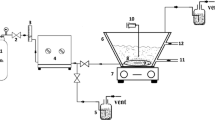Abstract
Iodoorganic compounds are known for taste and odor problems in drinking waters. Iodoorganic compounds can be more toxic than chloro- and bromoorganic analogues. There is therefore a need to control the formation of iodoorganic compounds in water treatment plants during ozone oxidation. The ozonation of iodide (I−) at environmental concentrations in water, below 100 μg/L, is known to yield only iodate (IO3 −). Nonetheless, there is few knowledge at higher iodide concentrations such as mg per L levels found in coastal areas and in surface waters contaminated by the hydraulic fracturing. Therefore, we have studied here the reaction of a high concentration of I−, of 20 μM, 2.54 mg/L, during ozonation and O3/H2O2 oxidation under various conditions. Results show the production of 20 % hypoiodous acid (HOI) and 80 % IO3 − in deionized water, whereas in natural waters results show the production of 8.0–14 % HOI, 75–89 % IO3 − and 2.7–10 % unknown iodine compounds. The addition of humic acids increased the production of unknown iodine compounds, possibly formed by reaction of natural organic matter and HOI. Overall, our findings show that ozonation of I− at mg/L levels produces HOI, raising the possibility of forming iodinated by-products, whereas the O3/H2O2 process can suppress the production of HOI.



Similar content being viewed by others
References
Allard S, Nottle CE, Chan A, Joll C, von Gunten U (2013) Ozonation of iodide-containing waters: selective oxidation of iodide to iodate with simultaneous minimization of bromate and I-THMs. Water Res 47:1953–1960
Bichsel Y, von Gunten U (1999) Oxidation of iodide and hypoiodous acid in the disinfection of natural waters. Environ Sci Technol 33:4040–4045
Bichsel Y, von Gunten U (2000a) Formation of iodo-trihalomethanes during disinfection and oxidation of iodide containing waters. Environ Sci Technol 34:2784–2791
Bichsel Y, von Gunten U (2000b) Hypoiodous acid: kinetics of the buffer-catalyzed disproportionation. Water Res 34:3197–3203
Daghrir R, Drogui P (2013) Coupled electrocoagulation-electro-Fenton for efficient domestic wastewater treatment. Environ Chem Lett 11:151–156
Gallard H, Allard S, Nicolau R, von Gunten U, Croue JP (2009) Formation of iodinated organic compounds by oxidation of iodide-containing waters with manganese dioxide. Environ Sci Technol 43:7003–7009
Hansson RC, Henderson MJ, Jack P, Taylor RD (1987) Iodoform taste complaints in chloramination. Water Res 21:1265–1271
Harkness JS, Dwyer GS, Warner NR, Parker KM, Mitch WA, Vengosh A (2015) Iodide, bromide, and ammonium in hydraulic fracturing and oil and gas wastewaters: environmental implications. Environ Sci Technol 49:1955–1963
Harris DC (1995) Quantitative chemical analysis. W.H. Freeman & Co., New York, pp 17–20
Hoigne J, Bader H (1994) Characterization of water-quality criteria for ozonation processes. 2. Lifetime of added ozone. Ozone Sci Eng 16:121–134
Liu Q, Schurter LM, Muller CE, Aloisio S, Francisco JS, Margerum DW (2001) Kinetics and mechanisms of aqueous ozone reactions with bromide, sulfite, hydrogen sulfite, iodide, and nitrite ions. Inorg Chem 40:4436–4442
Parker KM, Zeng T, Harkness J, Vengosh A, Mitch WA (2014) Enhanced formation of disinfection byproducts in shale gas wastewater-impacted drinking water supplies. Environ Sci Technol 48:11161–11169
Peters CJ, Perry R (1981) The formation and control of trihalomethanes in water treatment processes. Water Sci Technol Suppl 13:103
Plewa MJ, Wagner ED, Richardson SD, Thruston AD, Woo YT, McKague AB (2004) Chemical and biological characterization of newly discovered lodoacid drinking water disinfection byproducts. Environ Sci Technol 38:4713–4722
Richardson SD, Plewa MJ, Wagner ED, Schoeny R, Demarini DM (2007) Occurrence, genotoxicity, and carcinogenicity of regulated and emerging disinfection by-products in drinking water: a review and roadmap for research. Mutat Res Rev Mutat 636:178–242
Richardson SD, Fasano F, Ellington JJ, Crumley FG, Buettner KM, Evans JJ, Blount BC, Silva LK, Waite TJ, Luther GW, Mckague AB, Miltner RJ, Wagner ED, Plewa MJ (2008) Occurrence and mammalian cell toxicity of iodinated disinfection byproducts in drinking water. Environ Sci Technol 42:8330–8338
Sato I, Kudo H, Tsuda S (2011) Removal efficiency of water purifier and adsorbent for iodine, cesium, strontium, barium and zirconium in drinking water. J Toxicol Sci 36:829–834
Thomas JK (1965) Rates of reaction of the hydroxyl radical. Trans Faraday Soc 61:702–707
Urbansky ET, Cooper BT, Margerum DW (1997) Disproportionation kinetics of hypoiodous acid as catalyzed and suppressed by acetic acid-acetate buffer. Inorg Chem 36:1338–1344
Valent I, Adamcikova L, Sevcik P (1998) Simulations of the iodine interphase transport effect on the oscillating Bray–Liebhafsky reaction. J Phys Chem A 102:7576–7579
von Gunten U (2003a) Ozonation of drinking water: part I. Oxidation kinetics and product formation. Water Res 37:1443–1467
von Gunten U (2003b) Ozonation of drinking water: part II. Disinfection and by-product formation in presence of bromide, iodide or chlorine. Water Res 37:1469–1487
Wang YL, Nagy JC, Margerum DW (1989) Kinetics of hydrolysis of iodine monochloride measured by the pulsed-accelerated-flow method. J Am Chem Soc 111:7838–7844
Yates BJ, Darlington R, Zboril R, Sharma VK (2014) High-valent iron-based oxidants to treat perfluorooctanesulfonate and perfluorooctanoic acid in water. Environ Chem Lett 12:413–417
Acknowledgments
This work was supported by National Research Foundation of Korea (NRF) Grants funded by the Korea government (MEST) (NRF-2013R1A1A2074404 and NRF-2014M3C8A4031049).
Author information
Authors and Affiliations
Corresponding author
Electronic supplementary material
Below is the link to the electronic supplementary material.
Rights and permissions
About this article
Cite this article
Lee, HJ., Kim, HH., Lee, H. et al. Reaction of aqueous iodide at high concentration with O3 and O3/H2O2 in the presence of natural organic matter: implications for drinking water treatment. Environ Chem Lett 13, 453–458 (2015). https://doi.org/10.1007/s10311-015-0519-1
Received:
Accepted:
Published:
Issue Date:
DOI: https://doi.org/10.1007/s10311-015-0519-1




